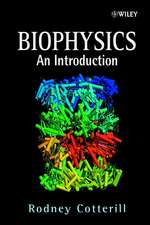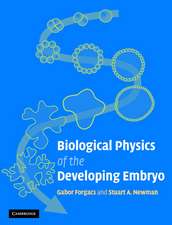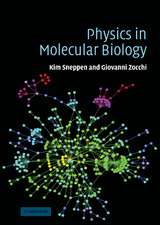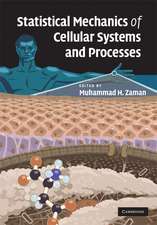Biophysical Tools for Biologists: In Vivo Techniques: Methods in Cell Biology, cartea 89
John J. Correia, H. William Detrich IIIen Limba Engleză Hardback – 2 dec 2008
- Describes techniques in the context of important biological problems
- Delineates critical steps and potential pitfalls for each method
Din seria Methods in Cell Biology
- 31%
 Preț: 702.75 lei
Preț: 702.75 lei - 31%
 Preț: 737.25 lei
Preț: 737.25 lei - 9%
 Preț: 734.41 lei
Preț: 734.41 lei - 31%
 Preț: 696.19 lei
Preț: 696.19 lei - 31%
 Preț: 695.58 lei
Preț: 695.58 lei - 32%
 Preț: 694.90 lei
Preț: 694.90 lei - 27%
 Preț: 702.22 lei
Preț: 702.22 lei - 24%
 Preț: 685.52 lei
Preț: 685.52 lei - 9%
 Preț: 621.87 lei
Preț: 621.87 lei - 31%
 Preț: 704.39 lei
Preț: 704.39 lei - 27%
 Preț: 745.66 lei
Preț: 745.66 lei - 31%
 Preț: 699.50 lei
Preț: 699.50 lei - 31%
 Preț: 703.51 lei
Preț: 703.51 lei - 27%
 Preț: 700.08 lei
Preț: 700.08 lei - 31%
 Preț: 706.55 lei
Preț: 706.55 lei - 23%
 Preț: 698.33 lei
Preț: 698.33 lei - 31%
 Preț: 700.08 lei
Preț: 700.08 lei - 31%
 Preț: 699.23 lei
Preț: 699.23 lei - 31%
 Preț: 749.64 lei
Preț: 749.64 lei - 31%
 Preț: 747.89 lei
Preț: 747.89 lei - 32%
 Preț: 741.01 lei
Preț: 741.01 lei - 9%
 Preț: 746.61 lei
Preț: 746.61 lei - 28%
 Preț: 697.85 lei
Preț: 697.85 lei - 31%
 Preț: 742.72 lei
Preț: 742.72 lei - 28%
 Preț: 700.51 lei
Preț: 700.51 lei - 32%
 Preț: 812.63 lei
Preț: 812.63 lei - 31%
 Preț: 818.59 lei
Preț: 818.59 lei - 32%
 Preț: 815.13 lei
Preț: 815.13 lei - 32%
 Preț: 811.43 lei
Preț: 811.43 lei - 32%
 Preț: 811.16 lei
Preț: 811.16 lei - 32%
 Preț: 790.48 lei
Preț: 790.48 lei - 9%
 Preț: 818.84 lei
Preț: 818.84 lei - 31%
 Preț: 820.31 lei
Preț: 820.31 lei - 33%
 Preț: 800.96 lei
Preț: 800.96 lei - 33%
 Preț: 800.70 lei
Preț: 800.70 lei - 32%
 Preț: 810.82 lei
Preț: 810.82 lei - 39%
 Preț: 810.62 lei
Preț: 810.62 lei - 29%
 Preț: 802.50 lei
Preț: 802.50 lei - 33%
 Preț: 799.66 lei
Preț: 799.66 lei - 33%
 Preț: 797.41 lei
Preț: 797.41 lei - 39%
 Preț: 801.98 lei
Preț: 801.98 lei - 39%
 Preț: 805.96 lei
Preț: 805.96 lei - 28%
 Preț: 814.11 lei
Preț: 814.11 lei - 28%
 Preț: 817.11 lei
Preț: 817.11 lei
Preț: 688.12 lei
Preț vechi: 995.06 lei
-31% Nou
Puncte Express: 1032
Preț estimativ în valută:
131.68€ • 138.11$ • 109.61£
131.68€ • 138.11$ • 109.61£
Carte tipărită la comandă
Livrare economică 25 martie-08 aprilie
Preluare comenzi: 021 569.72.76
Specificații
ISBN-13: 9780123725219
ISBN-10: 0123725216
Pagini: 704
Dimensiuni: 191 x 235 x 36 mm
Greutate: 1.41 kg
Editura: ELSEVIER SCIENCE
Seria Methods in Cell Biology
ISBN-10: 0123725216
Pagini: 704
Dimensiuni: 191 x 235 x 36 mm
Greutate: 1.41 kg
Editura: ELSEVIER SCIENCE
Seria Methods in Cell Biology
Public țintă
Cell biologists, biophysicists, pharmacologists, and molecular biologistsCuprins
Section 1. Fluorescence Methods
1) Photoactivation and Photobleaching Techniques for Analysis of Organelle Biogenesis in vivo
2) Analysis of the Dynamics of Living Cells by Fluorescence Correlation Spectroscopy
3) Molecular Sensors Based on Fluorescence Resonance Energy Transfer to Visualize Cellular Dynamics 4) Real-Time Fluorescence of Protein Folding in vivo
5) Microfluidic Glucose Stimulation of Ca+2 Oscillations in Pancreatic Islets
Section 2. Microscopic Methods
6) Introduction to Optical Sectioning: Confocal, Deconvolution, and Two-Photon
7) Use of Electron Tomography to Elucidate Sub-Cellular Structure and Function
8) Proteomics of Macromolecular Complexes by Cellular Cryo-Electron Tomography
9) Total Internal Reflectance Microscopy (TIRF)
10) Atomic Force Microscopy of Living Cells
11) Real-Time Kinetics of Gene Activity in Individual Bacteria
12) Measurement of Cytoskeletal Proteins Globally and Locally in vivo
13) Infrared and Raman Microscopy in Cell Biology
14) Imaging Fluorescent Mice in vivo by Confocal Microscopy
15) Nanoscale Imaging of Intracellular Fluorescent Proteins: Breaking the Diffraction Barrier
Section 3. Methods at the In Vitro/In Vivo Interface
16) Analysis of Protein Posttranslational Modification by Mass Spectrometry
17) Imaging Mass Spectrometry
18) Wet EM Using Quantum Dots
19) Single Cell Capillary Electrophoresis
Section 4. Methods for Diffusion, Viscosity, Force and Displacement
20) Single-Molecule Force Spectroscopy in Living Cells
21) Magnetic Bead Force Applications
22) Measurement of Membrane-Cytoskeleton Adhesion Using Laser Optical Tweezers
23) Cellular Rheological Measurements in vivo
24) Physical Behavior of Cytoskeletal Networks in vitro and in vivo
25) Force Regulation of Microtubule Dynamics in Fission Yeast
Section 5. Techniques for Protein Activity, Protein-Protein and Protein-RNA Interactions
26) Quantifying Protein Activity Using FRET and FLIM Microscopy
27) Measurement of Protein-Protein Interactions in vivo Using FRET and FLIM
28) Measurement of RNA Interactions in vivo Using Molecular Beacons –
Section 6. Computational Modeling
29) Stochastic Modeling in Cell Biology
30) Computational Methods for Analyzing Patterns in Dynamic Biological Phenomena: An Application to Microtubule Dynamics
31) Computational Modeling of Self-Organized Spindle Formation
1) Photoactivation and Photobleaching Techniques for Analysis of Organelle Biogenesis in vivo
2) Analysis of the Dynamics of Living Cells by Fluorescence Correlation Spectroscopy
3) Molecular Sensors Based on Fluorescence Resonance Energy Transfer to Visualize Cellular Dynamics 4) Real-Time Fluorescence of Protein Folding in vivo
5) Microfluidic Glucose Stimulation of Ca+2 Oscillations in Pancreatic Islets
Section 2. Microscopic Methods
6) Introduction to Optical Sectioning: Confocal, Deconvolution, and Two-Photon
7) Use of Electron Tomography to Elucidate Sub-Cellular Structure and Function
8) Proteomics of Macromolecular Complexes by Cellular Cryo-Electron Tomography
9) Total Internal Reflectance Microscopy (TIRF)
10) Atomic Force Microscopy of Living Cells
11) Real-Time Kinetics of Gene Activity in Individual Bacteria
12) Measurement of Cytoskeletal Proteins Globally and Locally in vivo
13) Infrared and Raman Microscopy in Cell Biology
14) Imaging Fluorescent Mice in vivo by Confocal Microscopy
15) Nanoscale Imaging of Intracellular Fluorescent Proteins: Breaking the Diffraction Barrier
Section 3. Methods at the In Vitro/In Vivo Interface
16) Analysis of Protein Posttranslational Modification by Mass Spectrometry
17) Imaging Mass Spectrometry
18) Wet EM Using Quantum Dots
19) Single Cell Capillary Electrophoresis
Section 4. Methods for Diffusion, Viscosity, Force and Displacement
20) Single-Molecule Force Spectroscopy in Living Cells
21) Magnetic Bead Force Applications
22) Measurement of Membrane-Cytoskeleton Adhesion Using Laser Optical Tweezers
23) Cellular Rheological Measurements in vivo
24) Physical Behavior of Cytoskeletal Networks in vitro and in vivo
25) Force Regulation of Microtubule Dynamics in Fission Yeast
Section 5. Techniques for Protein Activity, Protein-Protein and Protein-RNA Interactions
26) Quantifying Protein Activity Using FRET and FLIM Microscopy
27) Measurement of Protein-Protein Interactions in vivo Using FRET and FLIM
28) Measurement of RNA Interactions in vivo Using Molecular Beacons –
Section 6. Computational Modeling
29) Stochastic Modeling in Cell Biology
30) Computational Methods for Analyzing Patterns in Dynamic Biological Phenomena: An Application to Microtubule Dynamics
31) Computational Modeling of Self-Organized Spindle Formation














